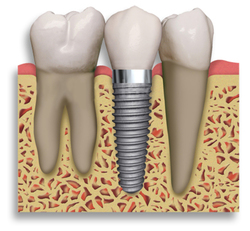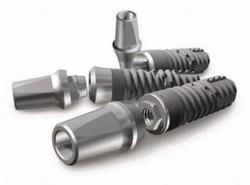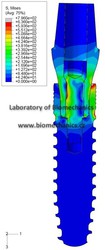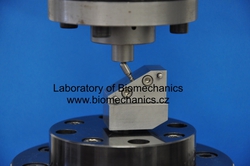
Dental and orofacial system
Numerical Analyses and Experimental Testing of Dental Implants
Project description:

Schematic picture of dental implant

Dental implants

FE analysis of the dental implant model

Dental implant prototype fixwd in testing machine.
The issue of dental biomechanics has been solved at our workplace since 1996 under the successful cooperation with the majority of local manufacturers of dental implants (Lasak s.r.o., Dentalmechanik s.r.o., Medin Orthopaedics a.s., etc.) and a number of clinical workplaces (Institute of Dental research, First Faculty of Medicine, Charles University in Prague and General University Hospital, Department of Stomatology, First Faculty of Medicine, Charles University in Prague and General University Hospital, etc.). At present, our workplace is capable of performing computational FEM analyses of solidity for any type of dental implants, and designing construction changes of individual implants based on these analyses. The results of FEM analyses are very much dependent on the quality of input data (the magnitude of masticatory forces, material parameters of bone tissue, etc.), therefore a number of partial procedures was devised in order to minimize the input errors:
- “In Vivo” mastication kinematics measuring: the methodology “in vivo” was devised at our workplace for measuring the masticatory kinematics and determining the magnitude and direction of masticatory force. Using this method a series of data for mandible motion kinematics were collected together with determining the bite force for various locations of the bite and various hardness of the chewed food- These data may be used as input data for FEM analyses.
- Material models of mandible bone tissue: at our workplace, we also devised the methodology for designing a 3D model of human jaw using CT images, including heterogeneous material properties collected from the values of shade of grey in individual images. This method may lead to giving precision to the results of FEM analyses for dental implant models.
Currently, our workplace is also capable of performing mechanical testing of dental implant prototypes according to the international standard CSN EN ISO 14801:2008 - Dynamic fatigue test for endosseous dental implants. The aim of performed test is to create a fatigue diagram and determine the limit fatigue loading – i.e. maximum periodical loading while the implant will endure 5 million cycles. Other determined values are the limit static loading and maximum bending moment achieved during limit fatigue loading on endosseous implant.
Tomáš Goldmann PhD ; doc. Ing. Radek Sedláček, Ph.D.Resesrchers:
Dentamechanik s.r.o.; LASAK, s.r.o.; Medin Orthopaedics, a.s.
Cooperation:
Literature:
- Goldmann T., Himmlová L., Aleksic Z., Ihde S.: The Use of Finite Element Analysis to Model Bone-Implant Contact with Basal Implants. Oral Surgery, Oral Medicine, Oral Pathology, Oral Radiology, and Endodontology. 2008, 106(1), 309-316.
- Goldmann T., Ihde S., Kuželka J., Himmlová L.: Bendable vs. Angulated Dental Implants: Consideration of Elastic and Plastic Material Properties Based On Experimental Implant Material Data and FEA. Biomedical Papers. 2008, 152(2), 309-316
- Ihde S., Goldmann T., Himmlová L., Aleksic Z.: The Use of Finite Element Analysis to Model Bone-Implant Contact with Basal Implants. Oral Surgery, Oral Medicine, Oral Pathology, Oral Radiology, and Endodontology. 2008, 106(1), 39-48
- Ihde S., Goldmann T., Himmlová L., Aleksic Z., Kuželka J.: Implementation of Contact Definitions Calculated by FEA to Describe the Healing Process of Basal Implants. Biomedical Papers. 2008, 152(1), 169-173
- Bouda T., Horák Z.: Numerical FE analyses of the dental implants MEDIN. Praha: ČVUT FS, Ústav mechaniky, Laboratoř biomechaniky člověka, 2009. 12105/09/06. 9 s. (in Czech).
- Himmlová, L., Dostálová, T., Kácovský, A., Konvičková, S.: Influence of Implant Length and Diameter on Stress Distribution: a Finite Element Analysis. The Journal of Prosthetic Dentistry. 2004, vol. 91, no. 1, s. 20-25.

